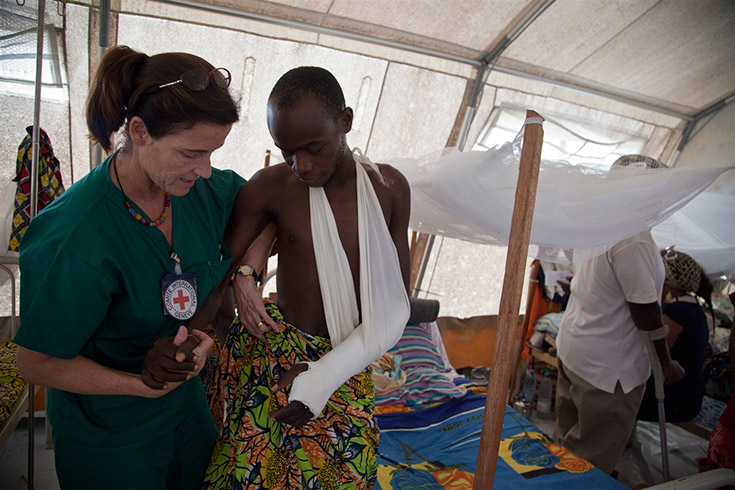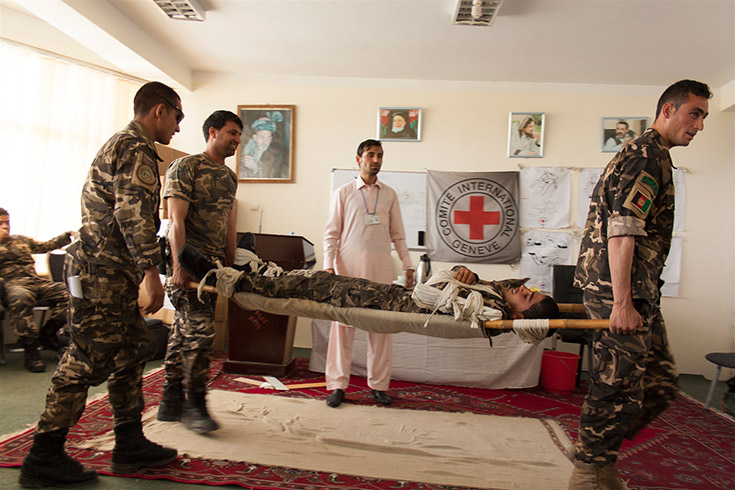No more healthcare victims, laws must be respected: Four years of Healthcare in Danger
In conflicts and upheavals worldwide, violence disrupts healthcare services when they are needed most. Civilians and fighters die of injuries that they should survive, while the entire population can be deprived of essential services, such as vaccination programmes, maternal and childcare or assistance for chronic diseases.

Communal hospital in Bangui, Central African Republic : A patient in one of the annexed tents of the hospital. These tents were set up owing to the high number of people seeking treatment (all photos ICRC)
Violence against healthcare workers still leads to numerous deaths. This isn’t down to poor conditions, but because airstrikes destroy hospitals, ambulances are stopped at checkpoints, and doctors, nurses and patients are attacked.
Such violent acts limit access to healthcare services for those most in need and disrupt healthcare systems. The human cost of violence is enormous (see movie below) and leads to severe immediate and long-term consequences. Yet protecting access to healthcare and its safe delivery is possible if authorities, weapon bearers, health providers and humanitarians put in place practical measures.
"We can’t tolerate more victims. Laws must be respected," says the Healthcare in Danger (HCiD) project, an initiative of the Red Cross and Red Crescent Movement. With its partners, the HCiD is calling on states, health organisations and the civil society for stronger action to implement concrete measures at a local and national level.
The Life & Death campaign, launched by the International Committee of the Red Cross (ICRC) to raise awareness on the issue of violence against health care, celebrates its fourth anniversary today (August 19, 2015) on the World Humanitarian Day. This campaign is integral part of the HCiD project, which is working with states and other influential actors to promote the implementation of measures to improve the security and delivery of effective and impartial healthcare during armed conflict and other emergencies. Its four priority issues are to safeguard healthcare against:
-
Attacks on services and patients
-
Unlawful obstruction to the delivery of health services
-
Discrimination in the treatment of patients
-
Armed entry by weapon bearers into health structures
During the last four years, ICRC delegations around the world have been collecting data on attacks against healthcare at a local level. The latest report, Violent Incidents Affecting the Delivery of Health Care, is based on data on 2,398 incidents, collected between January 2012 and December 2014 from various sources in 11 countries where ICRC field teams are active.
The findings are alarming: over 4,200 people were direct victims of violence against healthcare. Five-hundred-and-ninety-eight healthcare workers were killed, beaten or wounded. More than 700 medical transports were affected, directly or indirectly. Over 50 per cent of attacks targeted or occurred around or even inside healthcare facilities; 1,134 healthcare workers were subjected to threats and/or coerced to violate medical ethics or to provide free treatment.
The HCiD project has brought together different key players to tackle the issue. Several strategic partners form part of a growing ‘Community of Concern’: World Health Organization (WHO); Médecins sans frontières (MSF); World Medical Association (WMA); International Committee of Military Medicine (ICMM); International Council of Nurses (ICN); International Hospital Federation (IHF); World Confederation for Physical Therapy (WCPT); The Executive Council of the World Federation for Medical Education (WFME), and International Federation of Medical Students Association (IFMSA).
Several states and international organisations are also supporting the project. Lichtenstein and Norway have provided funding and the European Union has sponsored the Life & Death poster campaign across cities in Europe in 2011. The images were shot by the renowned war photojournalist, Tom Stoddart.

Logar Province, Pul-i-Alam, Afghanistan. Participants of the first aid training organised by the ICRC learn how to make a stretcher using a ‘patou’ (shawl) and two pieces of wood (photo: ICRC / Barry, Jessica)
As a result of diplomatic co-operation, HCiD was discussed at the 67th World Health Assembly in August 2014. In December 2014, the 69th Session of the UN General Assembly passed four resolutions on health careworkers, strengthening the role and responsibilities of states.
Protecting the safety of health-care workers is now also included in the UN Sustainable Development Goals.
As part of the HCiD project, 12 expert workshops were held worldwide between April 2012 and 2014. There, policymakers, academics, healthcare professionals, weapon bearers and civil society representatives worked together and identified recommendations and practical measures to improve safe access to health care.
These recommendations are now gathered in a number of guidance documents addressing different key players: legislators, healthcare workers, ambulance and pre-hospital service providers, military forces, hospital managers.
In June 2015, a publication providing armed groups with information on International Humanitarian Law obligations and operational practices for the protection of healthcare was launched. It is the result of a two-year consultation process with more than 30 armed groups engaged in non-international armed conflicts around the world.
Another major achievement saw light later in June when five major health organisations forming part of the HCiD Community of Concern adopted the first ever common ethical principles of healthcare.
The objective of the first four years of the project was to raise awareness, collect and analyse data and bring experts together to prepare recommendations for states, military and various medical actors. The International Conference of the Red Cross and Red Crescent in December 2015 will mark a transition towards a bottom-up approach encouraging states and national societies to take the lead and implement the developed recommendations in their local contexts.
Attacks on healthcare providers and their patients are frequent in modern conflict, despite being expressly forbidden under the Geneva Conventions of 1949. States play a key role in addressing the problem, but that role needs to be reinforced. States can adapt and better implement their national legislation, as highlighted in the HCiD recommendations for States published in February 2015.
The ICRC President, Mr Peter Maurer, has often reminded that healthcare workers and patients need results. He says: "While many countries have taken steps to tackle obstacles to the delivery of healthcare, more has to be done. We need to see good practice shared, and international co-operation and assistance strengthened, so that the wounded and the sick may continue to receive care, and healthcare workers may continue to provide it."
https://youtu.be/Cr3eknFzhWs
Follow the HCiD on Twitter @HCIDproject and join our anniversary celebrations at #HCID4yrs
Read more on the campaign
Become part of the Community of Concern
Tom Stoddart, 20/08/2015